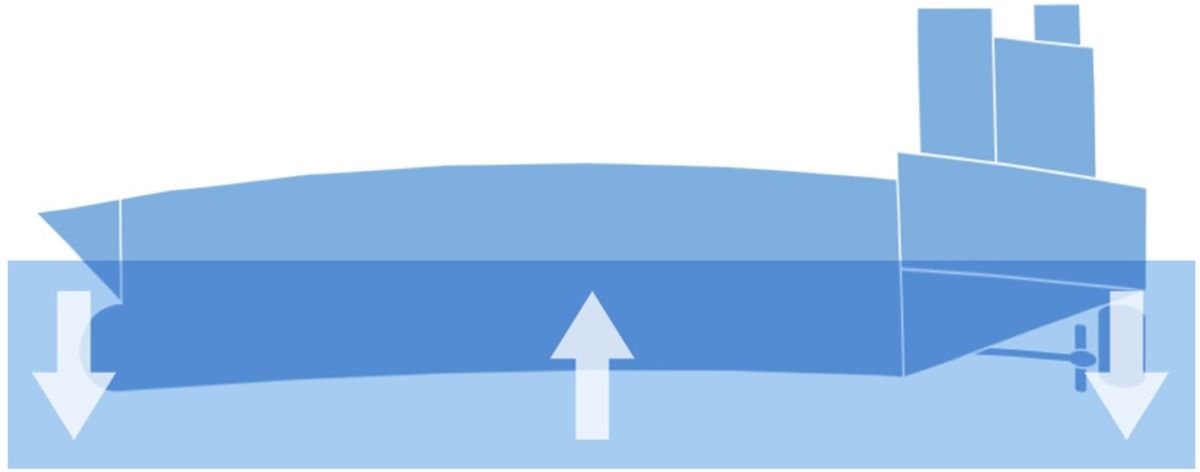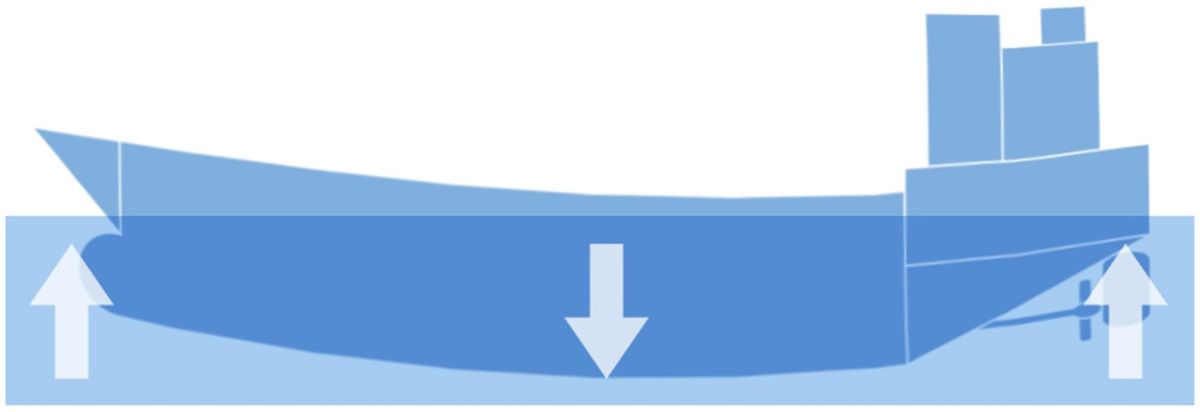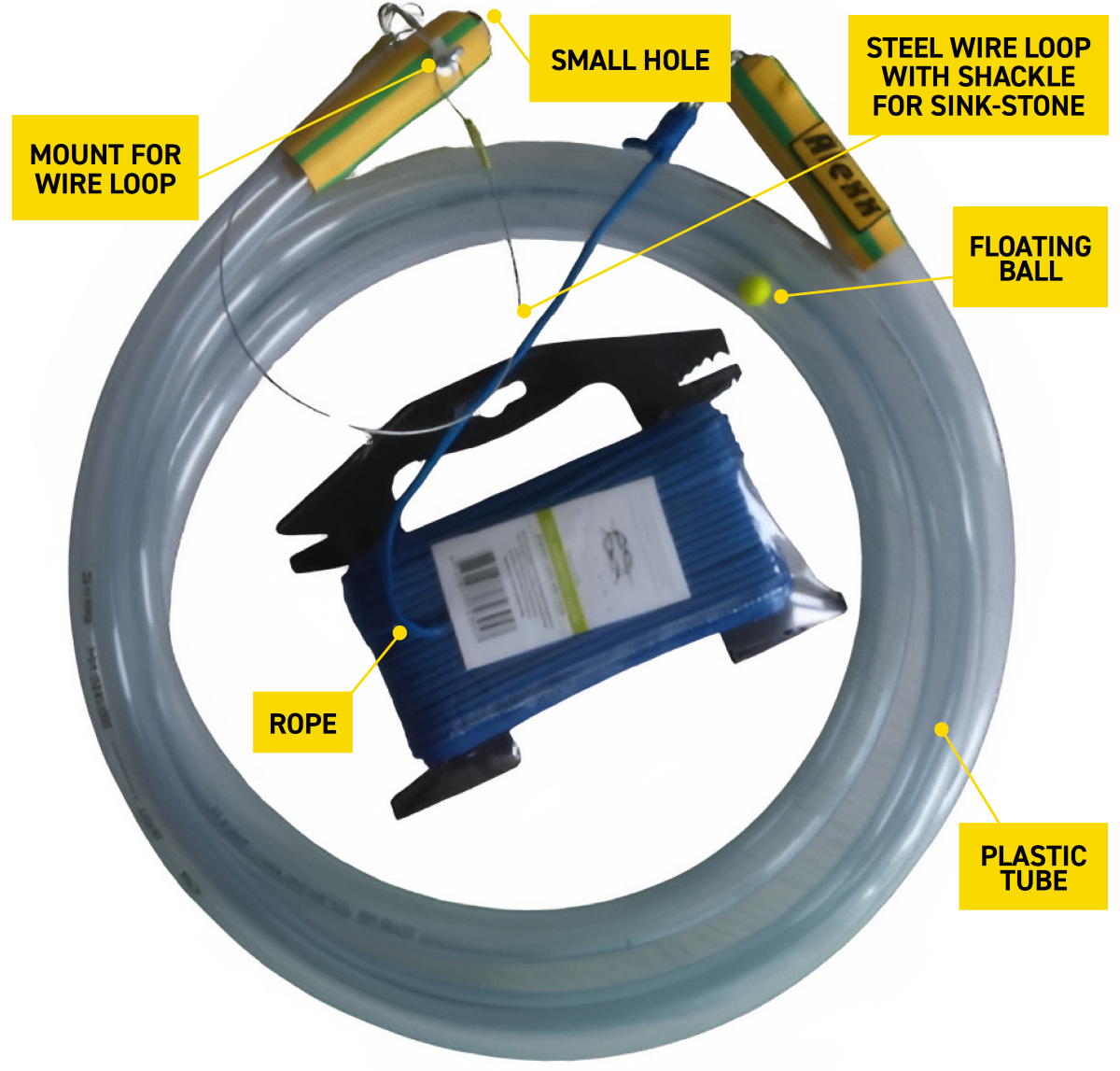This website uses cookies so that we can provide you with the best user experience possible. Cookie information is stored in your browser and performs functions such as recognising you when you return to our website and helping our team to understand which sections of the website you find most interesting and useful.
DRAFT SURVEY CALCULATION – PRACTICAL GUIDANCE
Published: 14 December 2023
WHAT IS THE PURPOSE OF A DRAFT SURVEY?
Draft surveys play a crucial role in determining the quantity of cargo loaded onto a ship. While based on the simple principle of Archimedes’ law of floatation, the calculation process can be complex due to the ship’s shape, non-linear changes in draft due to hog and sag, and external weather conditions.
Simply put, the weight of the cargo is calculated between the difference of the weight of the ship before and after loading. Allowances are made for ballast and other known weights.
Disputes can be prevented by managing the risk at the time of the fixture by clearly indicating which figure would be binding.
This practical guidance provides an overview of the key concepts and considerations involved in conducting a draft survey for ships.
USEFUL DEFINITIONS
LIGHTSHIP
This is usually the weight of the ship when it was built with operational conditions including the engine, accommodation and cargo space but does not include crew, cargo, fuel, ballast, fresh water and stores. This is thought to be increasing around 0.2% per annum due to the additional layers of paint, change of equipment and mud in the tanks.
CONSTANT
Constant is the difference in weight of the calculated lightship (by draft survey without the cargo) and it’s tabular figures from the ships book at a given time. This is the result of the weight of crew, additional weight added to the lightship since new build i.e. rust and any added metal, mud, sludge and silt which is usually not accounted for. Therefore it is important to bear in mind that it is never constant and can vary. In practice the initial draft survey calculation can be used to work out the constant at that time.
Often this calculated constant is compared with the declared constant or historical constant to sense check the cargo figures. This comparison may only be a warning flag of a possible error in the draft survey rather than an issue in itself. It is important to understand that the ‘constant’ may fluctuate, e.g. because of the variable amount of mud deposit.
HOG

Hogging occurs when the forward and the after end of a ship is much heavier than the midship. In mathematical terms, this means when the mean of forward and aft draft is bigger than the midship draft (ideally these should be same).
SAG

Sagging occurs when the midship section is heavier than the forward and aft. In mathematical terms, this means when the midship draft is bigger than the mean of forward and aft draft (ideally these should be same).
FACTORS TO CONSIDER DURING THE DRAFT SURVEY
READING THE DRAFT MARK
All parties should read the draft close to the waterline to avoid parallax, for which a boat may be essential, and cost should be agreed beforehand. Mental notes of metre marks should be taken to avoid errors in metre reading. Always ensure that draft marks are equally spaced for accurate calculations.
At the time of reading the draft, it is recommended to check for unusual flex conditions by checking all six point readings versus the means.
While all ships hog/sag and sometimes twist, the actual flex tends to be typical in certain conditions (e.g. hogging in ballast condition) which is usually known by the chief officers. If after reading the draft, this is found to be against the norm, it could a warning sign of a possible error. In this case the reading of the draft should be double checked.
Waves can distort the reading, to eliminate this a wave dampening tube and /or manometer can be used to determine the draft on the offshore side of the ship.
WAVE DAMPENING TUBE
Waves cause fewer problems below the surface and a tube can be used to take advantage of this. A tube with a small hole, as seen below, is lowered with a weight. There is a float which represents the level of water that would not be affected by the wave because the water enters from the bottom and a draft reading can be taken for the midship.




Source: alexxplus.com
The top of the tube hangs from the rope and weight is added at the bottom of the pipe. The pipe has a small hole and a reading floating ball inside the tube.
MANOMETER
The other option is to set up a manometer on board to read the difference in the water level. A long hose is laid across the full stretch of the beam (extreme breadth to replicate the distance between the draft marks from port to starboard side) with a rigid pipe at both ends so that the level of water (height) can be measured easily.
If the hose cannot be laid across the full breadth, the height of the water level at the extreme breadth can be calculated by a similar triangle method and the sides should be placed the same length apart from the centreline and measured (BM1).

We should be reading MD (reading of manometer at the extreme beam) but we are reading M1D1.
BM/BM1=MD/M1D1
MD= BM/BM1 * M1D1
BM is half of the beam and beam is the BM1 apparent half of the beam. “B” is the centre of the ship between port and starboard side.
The difference of the actual draft will be half of the difference of the height of the manometer tubes reading.

USEFUL ALTERNATIVE IDEAS
A camera with a zoom function to observe and record the water movement vs. draft marks tends to work better than binoculars, especially at night. The recording can then be played back to other surveyors to agree the reading.
A laser level instead of a manometer (combined with boards or rulers aligned to midship freeboard marks) is very quick to set up.
Where draft marks cannot be safely accessed, lower a small camera on a heaving line (which may be connected to a mobile phone to watch live). This works especially well on stern marks. The camera may need to be stabilised for example by using a wooden board and another line.
BEFORE THE SURVEY
- Check the declared constant
- Check the calculated constant by previous draft surveys against the above declared constant and note any anomalies or trend
- Verify that all tables and the ship’s hydrostatic data is approved by class
- Note any modification/refit from the build e.g. fitting of a ballast water system which might change the lightship/constant
- Check if the ship has a list
- Examine the condition of hatch covers and cranes (this can effect trim and list), and ensure mooring is finished to avoid squat (the apparent change in draft due to movement of the ship)
- The ballast or bunkering operation must not be allowed during the draft survey, as these will change the draft.
CALCULATING THE BALLAST
Cross checking and sounding of the ballast tanks should be made against the designed pipe height for accuracy. Water finding paste should be used to get the correct reading.
It is also important to correctly interpolate calibration table values against the sounding to obtain accurate volumes for the required trim and the sounding.
The density of the ballast water should be established between all parties.
Avoid taking the soundings of empty double bottom tanks at low trim or even keel. It is best to take soundings with moderate trim by stern and should never be done when trimmed by head.
Avoid having partly filled tanks at the time of the draft survey, and if it cannot be avoided, ensure the water level is not in the area where tank calibration tables may be inaccurate (i.e. where the tank shape alters rapidly such as where a high tank transitions between double bottom and vertical space).
For full tanks: press them to ensure no air cushion remains between the frames or in the forward part of the tank – be mindful that they need to overflow by the highest vent.
DENSITY OF THE DOCK WATER
Determine the density of the dock water using a calibrated hydrometer to avoid confusion and ensure accurate calculations. Draft survey hydrometers are designed to be used for draft surveys and calibrated for calculation of weight in air (not in vacuum). Ensure readings are agreed upon before starting calculations.
Keep in mind that density can fluctuate rapidly in certain ports and may vary with depth and time, for example after heavy rainfall or because of tidal forces introducing more saltwater. To address these variations obtain water samples for density assessment at the forward, aft and midship sections, at approximately half of the ship’s draft depth. The average density is derived from these samples for enhanced precision in the calculation.
Additionally the quantity of the sludge, slop, bilges, duct keel and void space should be ascertained. The same should be done during initial or final surveys otherwise adjustment should be made to calculations.
CALCULATIONS
Even with experienced surveyors the correction can be applied wrong because signs can differ on ships. The data reference point should be adjusted if it is not the same. One example is longitudinal centre of flotation (LCF). This can be measured from Midship or after perpendicular. However, after all the corrections are applied everyone should have the same corrected displacement.
Therefore it is important to be able to explain the +/- sign convention used in the ship’s documentation to the surveyor and to detect if an error was made.
Care should be taken when reading the data from the hydrostatic table to ensure that the correct trim and density of the water is being used. The correct draft should also be used (i.e. not moulded draft).
To eliminate any issues with the hydrometer we recommend using the same equipment for the initial and the final survey.
EVIDENCE
A video recording and photos of the reading could be vital in proving the reading of the drafts. Any disputes should be discussed and recorded.
SUMMARY AND RECOMMENDATIONS
It is important to remember that shortage issues should be compared on a like-for-like basis. Attempting to reconcile differences between shore scale and a draft survey would be unfair, as they are two distinct methods of measurement. The charter party should clearly specify which figures are deemed correct and acceptable.
Ships should refrain from signing any survey report unless they agree with the readings and calculations and which can be supported by their own assessments.
The draft survey process should be carefully managed by the responsible officer, ensuring that at all stages of the calculation match their own and that any errors or disagreements are clarified immediately.
While consumables may not always be entirely accurate, their figures can still be used accordingly for calculations. It is crucial to rely on a calibrated book for reliable data.
Draft surveys might not be included in all nautical school curriculum, which is why officers are encouraged to practice and compare results to enhance their proficiency.
To avoid complications in determining the correct amount of ballast in the holds, it is advisable to avoid using hold ballast.
Even if the tank is full or empty, soundings should be employed and trim corrections applied.
Officers should seek advice from local surveyors on when to ballast to prevent the accumulation of silt, which could affect constants between surveys.
If any issues arise, club correspondents should be contacted to assist as soon as possible.
CONCLUSION
Draft surveys are crucial in bulk trade for accurate cargo quantity determination. It is essential to adhere to standard practices, use calibrated equipment, and seek expert advice when needed. By following these guidelines, potential disputes can be minimised, ensuring a transparent and accurate process for all parties involved.
For further information please do not hesitate to contact the loss prevention team.
For more loss prevention case studies and guidelines covering cargo, navigation, crew health and wellbeing and security visit our loss prevention section.

 English
English